
|
|||||||||||||||
|
| |||||||||||||||
|
Winter storms Sand moves offshore Diatoms and green algae Limpets, barnacles, chitons, and tubeworms Some algae and animals Mussel beds Perennial brown algae Coralline red algae |
Storms bring death and opportunity 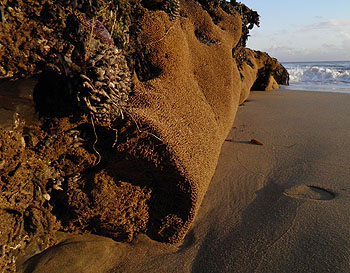 During a winter storm, this tubeworm colony was damaged by a large log or wave action, revealing its internal structure. The storm also damaged colonies of goose-neck barnacles (upper left) (Source: Kim Fulton-Bennett) Like the kelp beds, the rocky tide pools are pretty stripped down in January and February. There is usually plenty of bare rock exposed, both above and below the high tide line. The upper rocky areas may be bare because algae or animals have been removed by storm waves. The lower rocky areas are bare because storm waves have stripped away the sand that covers these rocks most of the year. All of this bare, exposed rock provides a once-a year opportunity for some algae and animals to colonize uninhabited space. On intertidal rocks covered by dense algal turf, gaps in the algal cover will often be recolonized by the same species that existed previously at the site, or by algae that live next to the cleared area. Even when a rock appears to be barren, microscopic remnants of the original algae often remain, and may be capable of regrowing. In addition, many algae release spores in winter that settle on nearby cleared areas. In some cases, this colonization process can take up to several years. In the mean time, weedy algae may colonize the space, just as fast growing plants spring up in a forest meadow after a large tree has fallen. By January or February, after several months of winter storms, most of the soft, frilly red algae have either died out or been torn completely off the rocks. The remaining algae are the hardiest of the hardy--those that are particularly good at surviving cold, rain, and pounding storm surf. By late winter, you will see many places where these algae have been ripped off the rock or scraped of by the pounding of logs and other floating debris. Sand moves offshore, exposing bare rocks One of the first things you will notice about tidepool areas in January and February is how little (if any) sand there is in small pocket beaches and around the tidepools. In some areas, the sand may be six to eight feet lower than in summer, especially after severe storms or when large swells arrive in late winter, after earlier storms have already removed much of the sand. You can sometimes tell areas where the sand has dropped because vertical rock faces that were formerly covered by sand are barren, without any visible algae or animals. This is unusual in the intertidal zone, where any available space is typically claimed by living creatures. As described below, a few algae and animals may try to colonize these bare areas, but most of them will die off when they are buried under sand that returns to the beach later in spring or summer. Storm waves typically strip sand from the uppermost portions of the beach and deposit it offshore--the larger the waves, the farther offshore the sand may be carried. Once offshore, this sand may be carried down current (typically to the south or east), or it may settle in low areas, such as channels between submerged rock reefs or kelp beds. In other cases, the sand forms temporary sand bars, even offshore of rocky coves. This can causes the waves to break farther from shore in the winter than in the summer months (much to the delight of surfers). Diatoms and green algae colonize bare rocks Almost immediately after intertidal rocks are exposed by dropping sand levels, they begin to be colonized, first by marine bacteria, then by diatoms, then by green algae. The bacteria and diatoms form a coating on the rocks that is invisible to the human eye, but provides a perfect grazing ground for limpets and chitons. Unless the area is heavily sand scoured or grazed by snails, the diatom films will soon be overgrown by green algae. Note: Rocks colonized by diatom films and sea lettuce are extremely slippery and are a major hazard for people exploring the tidepools. Sea lettuce thrives in winter After the marine bacteria and diatom films, green algae such as sea lettuce (in the genera Ulva and Enteromorpha) are the next colonizers of bare rock. Green algae do particularly well on rocks that are exposed by dropping sand levels (especially where frequent sand scour discourages grazing limpets). Within two to three weeks after being exposed, many bare rocks will acquire a slight green tint as they are colonized by these fast-growing green algae. Within a month or two, if the intertidal rock is not buried, scoured by sand, or cleared by grazers, sea lettuce may expand to cover almost all of the newly bared rock. However, this ephemeral algae is likely to die off when sand returns to the beaches during calmer periods. 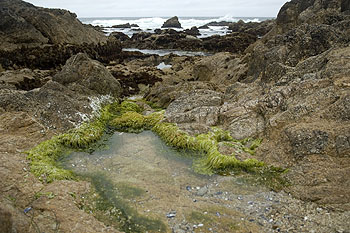 Sea lettuce can tolerate both brackish and fresh water, so it is often found in high tidal pools where runoff of fresh water makes it hard for other intertidal algae to survive. Unlike most marine algae, Sea lettuce will grow in brackish water. Thus, you can often find sea lettuce growing where freshwater streams, springs, or storm drains flow across intertidal rock ledges. Such runoff is often rich in plant nutrients from agricultural and home fertilizers. Patches of sea lettuce are particularly extensive in January and February, when fresh water runoff is at its yearly maximum. Although sea lettuce is fragile compared with many types of marine algae, it grows so high on intertidal rocks that seawater only reaches it during the highest tides. In this challenging environment there is less competition for space from other algae than in lower intertidal areas. Limpets, barnacles, chitons, and tubeworms colonize cleared areas 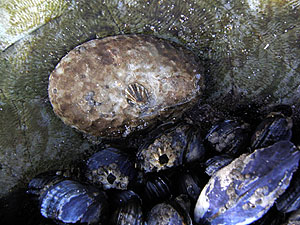 This owl limpet has tucked itself into the edge of a clump of mussels to wait out the low tide. Note the parallel lines in the thin algal turf, which are caused by the owl limpet's file-like radula. (Source: Kim Fulton-Bennett) 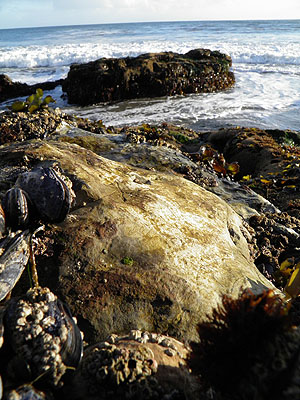 This photo shows an owl limpet's domain. This area of bare rock may have originally been created by battering waves, but the owl limpet keeps it free of both algae and animals by persistent grazing. (Source: (c) Kim Fulton-Bennett) Large gaps in the otherwise continuous beds of mussels and algal turf provide mute evidence of the massive logs that grind across horizontal rock surfaces like bulldozers and crash against vertical rock surfaces like battering rams during storms. However, such gaps provide opportunities for other algae and animals that are able to grow and expand during winter's turbulence. Grazing animals, such as limpets and chitons, migrate onto cleared areas to feed on diatoms and microscopic algae that settle on the newly bared rock. Owl limpets (Lottia gigantea), in particular, move to scoured areas, and may be able to keep such areas from being colonized by larger algae, barnacles, and mussels by scraping off any algal spores or larvae that may try to settle on the rock surface. Where the bedrock is relatively soft and erodible, however, even barnacles and limpets have a hard time holding on. Some kinds of tubeworms may also benefit when brown algae are thinned during the winter months. On the sides of rocky ledges, just below the mussel beds, you can often see large, bulbous, sand-colored colonies of Phragmatopoma tubeworms. Where mussels and algae have been torn out by winter storms, tubeworm colonies may grow to cover the exposed areas of bare rock. 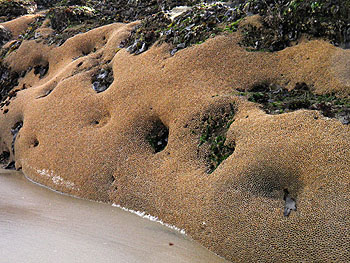 This large tubeworm colony has expanded during the winter months, almost engulfing the algae that peaks out of the few remaining gaps in the colony (Source: Kim Fulton-Bennett) During January or February you may see small tufts of algae sticking out between the tubeworms after being surrounded by the tubeworm colonies. Come summer, however, these same algae will have grown out and their blades will be long enough to practically cover the tubeworm colonies. During the summer months the sweeping movement of the blades of brown algae may limit the growth of the tubeworms (at high tide), but at low tide the blanket of algae helps keep the tubeworm colonies moist and out of the hot summer sun. Other early colonizers of intertidal rocks are tiny gray or brown acorn barnacles in the genus Chthamalus. Larvae of acorn barnacles begin to settle out on high intertidal rocks between January and March, with a peak in February. Acorn barnacles often form broad colonies that look as if someone had simply flung them up onto the rocks far above the intertidal zone. In fact, this is what actually happens in early spring, when high tides and steep, wind-driven waves splash acorn-barnacle larvae up onto high (and often dry) rocks. The newly settled (and still microscopic) larvae hunker down in tiny cracks and depressions to avoid drying out or being eaten by grazing limpets. Over the next few weeks, the larvae develop very rapidly and may start spawning when they are only two months old and just 1/8 inch across. Some algae and animals benefit from sand scour Polysiphonia thrives in winter On flat rocky platforms, a red alga called Polysiphonia actually benefits from the removal of sand in the winter months. This alga grows particularly well along the exposed coast northwest of Santa Cruz. Polysiphonia thrives only where its holdfast is buried under two to four inches of sand throughout most of the year. Like surf-grass roots, Polysiphonia holdfasts retain sediment and provide habitat for many small animals such as worms and crustaceans. Later in the spring and fall, when the sand fills in and covers the rock flats to depths of more than about four inches, Polysiphonia dies back. As soon as the sand moves away again, Polysiphonia will grow back quickly. In fact, new Polysiphonia sprouts can colonize former growing areas in only six weeks--even faster than other winter colonizers such as Mastocarpus (which take about twice as long). Surf grass reduces sand scour On the wide, flat rock platforms, surf grass Phyllospadix scouleri is another hardy perennial that usually survives the worst of the winter storms, though it often becomes tattered and brown as the winter progresses. The root-like rhizomes of the surf grass help hold sand in place that would otherwise be carried offshore by winter waves. Like feather boa kelp, the tips of the surf grass blades sometimes break off under severe conditions. This reduces drag on the plant, making it less likely that he rhizomes will be pulled off of the rock, while still keeping some leaf area for photosynthesis. In the worst of the winter storms, many small tidepool animals shelter around surf-grass rhizomes. Periwinkles dominate sand-scoured areas Among the sand-scoured Polysiphonia and surf-grass beds, the dominant grazers are tiny snails known as periwinkles (Littorina keenae). Although present all year, in winter time these little snails are just about the only grazing animal left in high intertidal sand-scour areas. Perhaps their small size allows them to shelter from the winter storms among Polysiphonia blades or holdfasts and surf grass rhizomes. Anemones survive abuse and burial 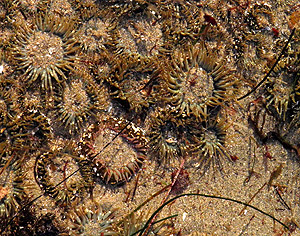 These colonial anemones do just fine being half buried in sand. (Source: Kim Fulton-Bennett) Yet another hardy survivor of winter storms and a champion at living among shifting sands are the anemones in the genus Anthopleura. Some of these greenish anemones form dense colonies consisting of hundreds or thousands of clones, each about an inch or less across. Other anemones, in a closely-related species, grow much larger (up to 10 inches across) and do not form colonies, though several individuals may share prime areas such as the edges of rock ledges or surge channels. Both the solitary and colonial Anthopleura anemones are champions at surviving on solid rock surfaces that are periodically buried and then exposed by shifting sands. Some colonies of anemones are only exposed when sand levels drop during the winter time. The rest of the year, they somehow survive being buried under as much as six feet of sand for up to three months at a time. 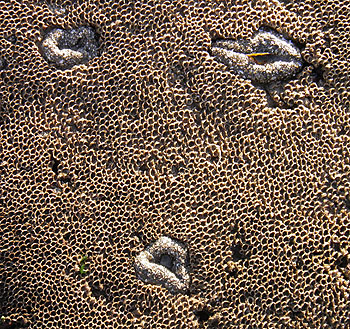 These solitary anemones have survived sand scour, but are in danger of being engulfed by colonial tubeworms. (Source: Kim Fulton-Bennett) Because they do not move around much, anemones must wait for prey to be swept into their tentacles by the action of the waves. Anemones find plenty to eat during winter--the same winter storms waves that tear animals off intertidal rocks often deliver these animals directly into the gullets of waiting anemones. Despite their soft bodies, colonial anemones are amazingly persistent in the face of abuse, whether by waves or humans. One marine biologist tried to remove a small Anthopleura colony from an intertidal rock ledge to see what animals would recolonize the area. He tried hand scrapers, scouring pads, and even a blow-torch, but was never able to remove all of the anemone tissue from the rock, so the colony kept growing back. Presumably the anemones were regrowing from tiny bits of mashed tissue, or perhaps their young were very good at colonizing smashed and scraped members of their own species. Mussel beds are torn up by waves and debris Not only algae, but many attached animals are torn off the rocks by winter waves. On the outer portions of rock ledges, beds of California mussels (Mytilis californianus) are often conspicuous in winter because the algae that covered them in summer have died back or been removed. However there may be large gaps in the mussel beds where redwood logs have been dragged over the rocks by winter storm surf during high tides. Where they remain intact, the mussel beds provide much-needed refuge for smaller animals and algae. You can often see short tufts of green or brown algae peeking out between the mussel shells, able to grow to the height of the mussels themselves, but no taller. Perennial brown algae are pruned back but survive Most of the intertidal algae you will see in January and February are perennial species that survive even after being severely "pruned" by winter waves. Though tattered and worn, these one- to three-inch-high tufts will survive just about anything. One notable example is the leathery red alga in the genus Mastocarpus, which somehow manages to colonize tiny cracks and toe-holds in upper intertidal rocks, where even barnacles and limpets fear to tread in winter. Mastocarpus may only be few inches high in January or February, but will grow to its full height of perhaps six or eight inches in summer. After the green algae such as sea lettuce (described below), Mastocarpus is one of the first colonizers of newly exposed bare rocks, growing to visible size within a couple of months after the rock has been cleared by winter storms. 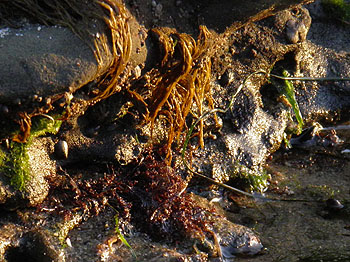 Endocladia muricata (maroon-colored algae at base of slope) and other algae growing in the shelter of a rock ledge. (Source: (c) Kim Fulton-Bennett) Another amazingly durable red algae is Endocladia muricata, sometimes called "nail-brush algae" because of it's tough, bristly appearance. In some areas you can find more Endocladia in winter than in summer, as it rapidly recolonizes areas that have been scraped down to bare rock. As one of the few algae that is reliably present in early spring, Endocladia provides shelter for young intertidal animals, such as lined shore crabs, which begin to settle into the tidepools in early spring (and are discussed in greater detail in March). A little lower down on the rocks, you may see tattered remnants of other perennial brown algae--rockweeds in the genus Silvetia and Fucus. Some rockweeds, such as Silvetia compressa release spores primarily in winter and spring, when sand levels are low and more bare rock surfaces are available for colonization. 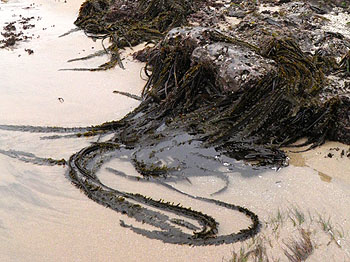 Feather-boa kelp (Egregia menziesii) is a very hardy perennial brown alga that survives in areas of strong wave energy and sand scour. (Source: Kim Fulton-Bennett) In the middle and lower intertidal areas, the most visible alga in February is likely to be Egregia menziesii, the feather boa kelp. Exposed to some of the most violent wave action, even this durable kelp is pruned by winter storms, leaving short segments only a foot or two in length (compared to their summer length of up to 20 feet). These shorter remnants are even more resistant to wave damage than the full-grown blades. The feather-boa's holdfast itself is even more durable than the rest of the alga. It is shaped like a low, rounded volcano, with stipes emerging from a protected "crater" in the middle, which protects the stipes from being scraped off by the bulldozer action of storm-driven logs and other debris. Another brown algae that survives in abbreviated form during January or February, especially along exposed coastal areas, is Laminaria sinclairii. By this time of year, the graceful, inch-wide blades of this kelp have been tattered or torn off entirely, leaving the stick-like stems or "stipes" sticking up through the water surface at low tide. Like many algae, Laminaria have amazing powers of regeneration. Their spatula-like blades may start to grow back after just a week or two of calmer weather. Even if all of its blades are totally removed, the Laminaria holdfast will survive to send out new blades. The new Laminaria blades will grow rapidly once the storm season is over, reaching full length by late spring or early summer. Coralline red algae grow lush in winter Still lower down in the intertidal, other hardy, low-growing organisms become obvious in January or February, when most of the overlying algae has been removed. Although they are present all year, the colorful pink crusts and branches of coralline red algae are more visible at this time of year, growing underneath the Laminaria and along the edges of tide pools. Some coralline red algae may even put on a growth spurt in winter, perhaps because they can obtain more sunlight without being shaded by the blades of larger algae. Coralline red algae are extremely tough, with hard skeletons of calcium carbonate (like the bones in our bodies). They also have a neat trick that helps them survive winter storms--if their holdfast is ripped off a rock and then deposited on another hard surface for a few days, it can reattach and keep growing. A few tidepool animals spawn in early spring Surprisingly, several tidepool animals spawn in January and February. Although this seems like a tough time of year to have babies, there are several possible advantages. For one thing, the prevailing currents at this time of year tend to flow toward shore. This means that the tiny drifting larvae released by many intertidal animals are unlikely to be swept far out to sea, away from the tidepools where their parents lived. Later in the spring, upwelling currents are more likely to carry drifting animals far from home. Another possible advantage is that certain types of food are more available in the winter time. For example, the thin algal films that form on newly cleared rocks provide the perfect food for some young grazing animals such as limpets and chitons. Similarly, the debris stirred up by winter storms provides food for some types of scavengers and filter feeders. A third advantage of spawning early in the year is that young animals will find plenty of vacant space on intertidal rocks. Such space will be at a premium later in spring, as intertidal algae grows more lush and both animals and algae begin to spawn and recolonize every available bare rock surfaces. Acorn barnacles spawn 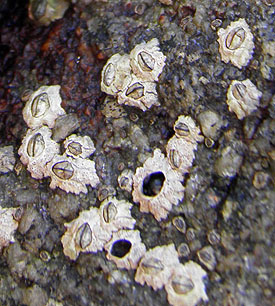 Acorn barnacles (about 1/6 inch wide) (Source: Kim Fulton-Bennett) Acorn barnacles in the genus Cthamalus are a classic example of intertidal animals that spawn before upwelling begins. Many barnacles begin to release larvae as early as January or February. This "early crop" of barnacle larvae will float around the open ocean for a month or so, but will return and settle down in intertidal areas before all the vacant rock spaces have been taken up by algae or other animals that colonize these areas en masse later in spring. The down-side of spawning early is that some young barnacles will end up settling on bare rocks that will be covered with sand later in summer. This can be deadly for the young barnacles because they won't be able to eat or breathe. But inevitably some early settlers survive, and live long enough to send out their own young, to try again. Many other types of barnacles spawn in March and April. Some chitons spawn Some intertidal animals minimize the chance of being carried too far from home by having larvae that drift only a few days or hours before settling back onto a rock. Several species of chitons (Ischnochiton interstinctus, Ischnochiton regularis, and Lepidozona mertensii) spawn in February. Their young spend just a week or two drifting as larvae before settling down. Rough limpets spawn Many limpets spawn in the winter time, presumably so that their young will find plenty of bare space and lots of young algae to eat when they settle on intertidal rocks. Rough limpets (Collisella scabra) are actually one of the later limpets to spawn, releasing young from January through March. Unlike the young of many limpets, the larvae of rough limpets spend months and months drifting around the ocean, and don't settle back down on intertidal rocks until summer or fall. Thus, these larvae are released at the last part of the storm season, but settle out during the calmest part of the year. Presumably this allows the larvae to colonize far and wide along the coast. Rough limpets live on relatively horizontal rock surfaces in the upper intertidal zone. This makes them easy to find, both for humans and for predators such as oystercatchers and other animals. Perhaps having their young being spread far and wide allows these limpets to find areas that are less picked over by predators. Mussel worms spawn 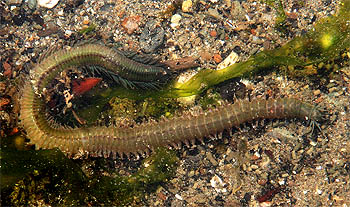 Growing up to 8 inches long, mussel worms are formidable predators of the tidepools. (Source: Lynette Schimming) One of the most spectacular (but seldom seen) events of spring is the spawning of mussel worms (Nereis vexillosa). You can often find the husks of these large worms, up to a foot long and half an inch in diameter, washed up on the beaches after a spawning event. The first monthly mussel worm spawning events of the year typically occur in January or February, typically around the time of the full moon. Similar events may occur each month throughout the spring and early summer, but the largest spawning events typically occur early in the year. For most of the year, these six- to ten-inch-long, feisty, many-legged wrigglers live in mucus tubes they secrete within mussel beds or in kelp holdfasts. They prowl around under the mussels eating just about anything they can find, from algae, bryozoans, and sponges to small shrimp and crabs. However, they don't seem to tolerate others of their own species. As one marine biologist put it, mussel worms are "very aggressive... extending an impressive set of jaws and biting and snapping at each other". Note: Mussel worms will also bite humans who try to pull them out of the mussel beds. Some time each spring, mussel worms reach sexual maturity and prepare for the one and only mating experience of their lives. And it is quite an experience. At midnight on the appointed night, each worm goes through a werewolf-like transformation. It's rear end turns into what biologists call an epitoke--basically a swimming sex machine. The worm's gonads expand dramatically, causing the back half of the worm to swell up like a balloon, while its digestive tract virtually disappears. The worm's rear legs turn into swimming paddles. It's eyes bulge out (“...the better to see you with, my dear..."). When the transformation is complete, The worm's body splits in half and the epitoke swims off, leaving the rest of the body behind to die. Typically all of the mussel worms in a particular area make this transformation simultaneously (imagine everyone in your town becoming a werewolf at the same time), typically within a few hours of midnight, around high tide. Like zombies in a B-grade horror movie, the mussel worm epitokes all swim upward toward the water surface. The resulting orgy has inspired many a marine biology writer. Here let me quote one of the best of these writers, Ed Rickets (the real-life "Doc" of Steinbeck's Cannery Row). "When moon and tide are favorable” the male epitoke “flinging caution to the winds... swims rapidly and violently through the water, shedding sperm as he goes... the females follow within a short time, releasing their eggs.” This mating process is truly a "bodice ripper" in the literal sense--the bodies of female worms literally rupture, ripping wide open to release eggs. Inevitably, both the males and females die shortly after mating. As if this wasn't enough melodrama for any movie, the mating frenzy is followed by a feeding frenzy, as fish and birds attack the weakened and dying epitokes. In fact, early spring spawning events provide a welcome source of food at a time of year when Central Coast waters are not very productive. This may all seem like a Romeo and Juliet tragedy, but there is something of a happy ending... at least for the young mussel worms. During the feeding frenzy, the fertilized mussel-worm eggs may sink toward the bottom, largely uneaten, because the predators are so busy eating their parents. The eggs hatch three or four days later. The mussel-worm larvae spend a little over a week drifting around, before settling back down into a new mussel bed, to begin the process anew. Tiny white sea stars give birth 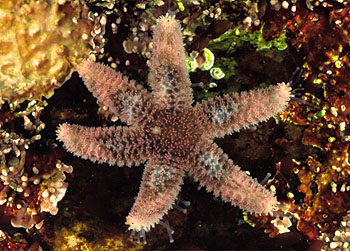 Leptasterias pusilla is a small but very beautiful sea star. (Source: Lovell and Libby Langstroth / Creative commons) If you're out exploring the tidepools at night in January (an occupation for the truly dedicated naturalist), look very carefully in the bottom of some of the sand-filled pools. In addition to seeing Ulva, coralline algae, and turban snails, you may find a tiny white sea star--Leptasterias pusilla. When full grown, this diminutive predator is only an inch and a half across. It lives only in Central Coast tidepools between Monterey Bay to Halfmoon Bay, where it hunts small limpets and snails. If you pick up one of these stars and look at its underside with a hand lens, you see may find that it is carrying dozens of tiny white eggs. Female Leptasterias carry 40 to 100 of these tiny white eggs during the winter months. In February or March, these eggs will hatch, releasing tiny little sea stars that will trundle off across the tidepool, looking for newly settled barnacles or periwinkles on which to feed. Another small white sea star, Leptasterias hexactis, also carries eggs during the winter months. Females of this species brood 50 to 1500 eggs for about six weeks. During this time, the female cannot eat, since she carries her eggs directly in front of her mouth. When not carrying eggs, Leptasterias hexactis typically lives in mussel beds and feeds on larger prey than Leptasterias pusilla, including sea cucumbers, snails, limpets, chitons, small mussels, and barnacles. |
